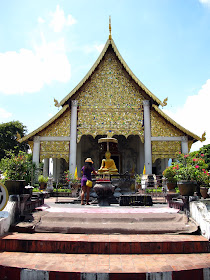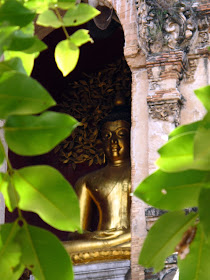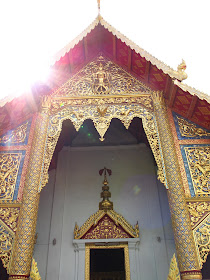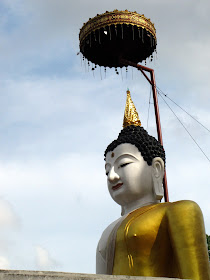Chiang Mai is also known as the rose of the North. I'm surprise it's not called the temple city or something given the number of temples in the moat itself.
Anyway, here goes... (in no particular order)
Wat Duang Dee
This Wat was fairly near where I had my lunch. I happened to saw a sign and thought, why not? It wasn't listed in the free map. The temple's compounded was shaded by some longan trees. It is said that Wat Duang Dee means The Good Luck Monastery.
Wat Phantao
As you walked along Phapokklao Road, the direction from 3 Kings Monument towards Chiang Mai Gate, you'll bound to reach this wat. Once part of Wat Chedi Luang, the temple got its name from the "thousand furnaces" that were used to cast the images for the main temple.
I like the waterfall near the temple, it's different from the rest of the temple, also it looks exceptionally cooling in the super hot day.
Wat Chedi Luang วัดเจดีย์หลวง
This is one of the recommended templet to visit. According to wikipedia, it means temple of the big stupa. It is obviously the bigger temple compared to the rest, on its ground, lies a ruined temple, dating from the 14th and 15th centuries. A severe earthquake in 1545 toppled part of the spire.
Wat Chedi Lung was once the home to the Emerald Buddha, the holiest religous treasure in Thailand (now kept in Wat Phra Kaew, Bangkok).
This is probably the only wat in Chiang Mai's old town that has both ruins and a temple building. I said probably as I have not been to all wat in the moat area.
I overheard a chinese tour guide saying that trees that have the cloth wrapped around them are not to be cut down.
Wat Phra Singh วัดพระสิงห์วรมหาวิหาร
This is the second wat that is recommended for visit in the moat area. It is built in the 14th century by King Pha Yu to enshrine the remains of his father, King Kham Fu. It appears that this wat may have been the first monastery to house the cultural treasure, Emerald Buddha.
Wat Phra Sing currently houses Phra Chao Thong Tip, the most venerated Buddha statue in northern Thailand. Cast in 1477, it is made of an alloy of gold and copper.
Wat Chiang Mun วัดเชียงมั่น
Wat Chiang Mun was the first royal temple built in the vicinity of Chiang Mai's ancient city, during 1296-1297 A.D by Phya Mungrai.
There are several valuable historical artifacts stored in this temple. The most significant being the white quartz Buddha image of "Phra Setangkamanee" or "Phra Kaew Khao" in Lanna style.
The other being a stone inscription written in 1581 A.D. which records histories of at Chiang Mun and the city of Chiang Mai.
Wat Khuan Ka Ma
I initially thought this wat is Wat Raiamontean (the next wat) due to close proximity to each other. I was walking back to hostel, just trying to use another road that the one I usually taken. This is along Maninopharat Road, where Chang Puak Gate is.
There isn't much information of this wat on google though but there's one of two site that mentioned of it. Of course, this is not as big as Wat Phra Singh or Wat Chedi Luang but I thought horse statues outside of the wat makes it different from the rest.
Wat Raiamontean
Just right next to Wat Khuan Ka Ma, looked up and you'll see a big Buddha statue, even if you don't step inside the wat compound. Like it's neighbour, Wat Khuan Ka Ma, there's isn't much info on this wat as well. Maybe because it is fair new, you can tell from the building that it is a "newbie" compared to the rest of the wat.
Don't you worry, these wat are only the tip on the iceberg, there are still many more wats to keep you occupy if you are a big temple fan. Grin.
Side note: Yay for Fridays! ^_^
























No comments:
Post a Comment